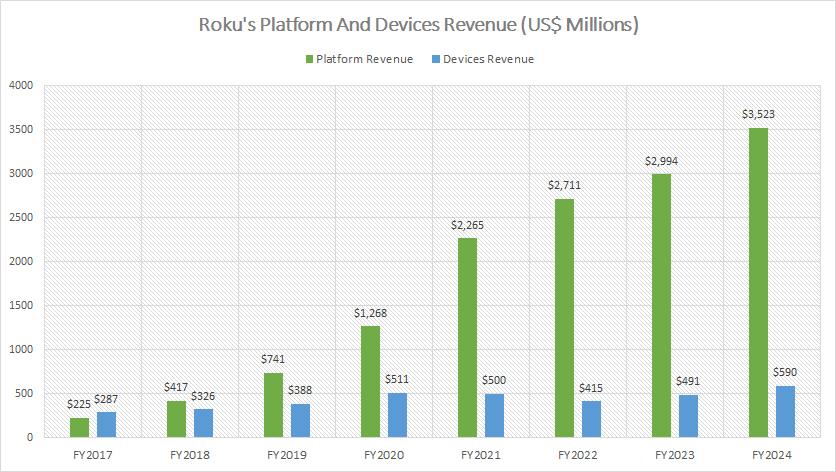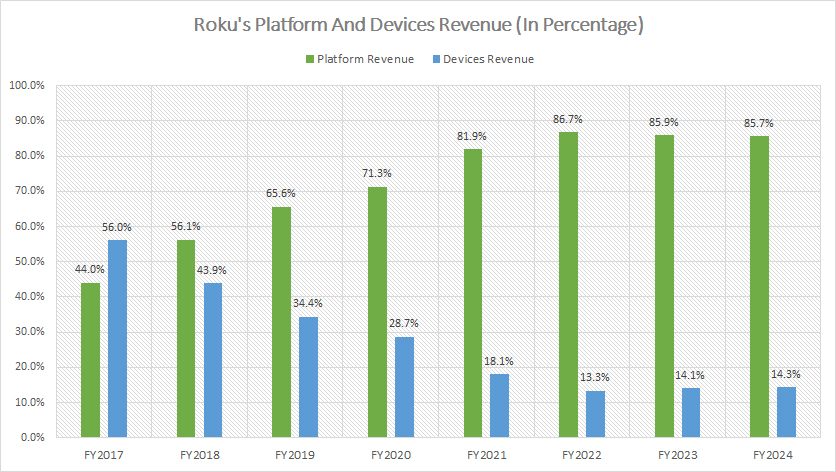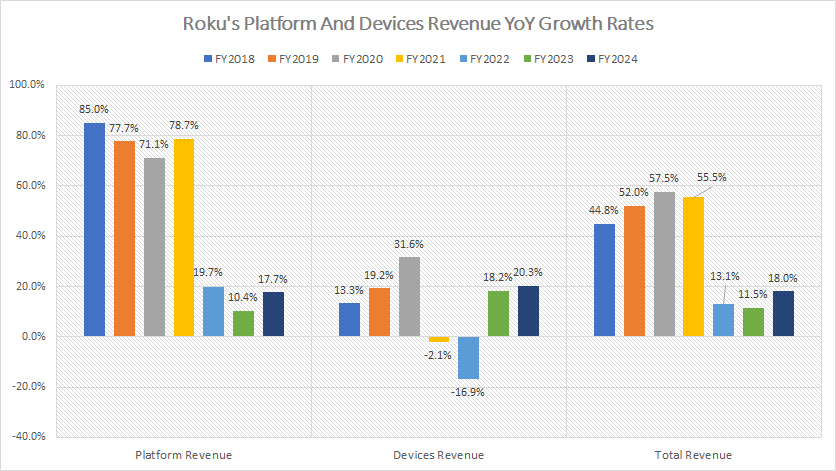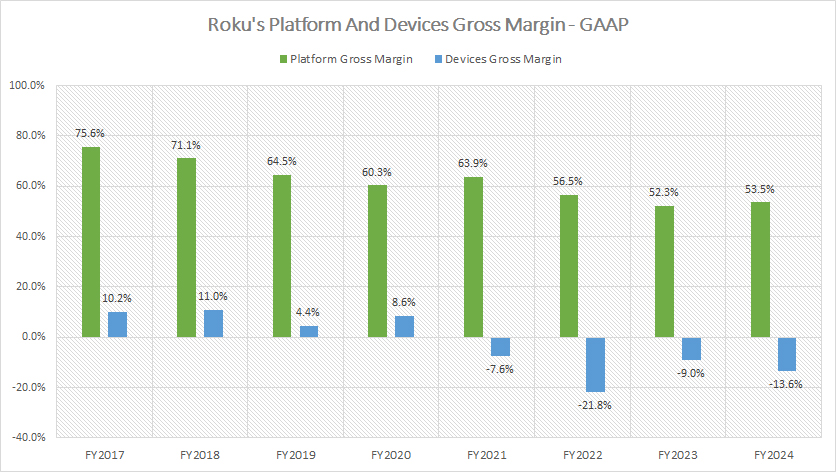
TV streaming. Pixabay image.
This article covers the revenue breakdown of Roku, Inc. (NASDAQ: ROKU). In addition to revenue, we also delve into the company’s profit and margins by segment.
Roku’s revenue streams consist of two sources: Platform and Devices. You may find more information about Roku’s segments here: Roku segments.
Investors interested in Roku’s other statistics may find more resources on these pages:
- Roku key stats: active accounts, streaming hours, and average revenue,
- Roku debt analysis, payment due, liquidity, and credit rating, and
- Roku cash flow and cash on hand analysis.
Please use the table of contents to navigate this page.
Table Of Contents
Definitions And Overview
O2. Roku Business Strategy
O3. How Does Roku Earn Revenue
Revenue Breakdown
C1. Revenue From Platform And Devices
C2. Percentage Of Revenue FromPlatform And Devices
Revenue Growth
C3. YoY Growth Rates Of Revenue From Platform And Devices
Profit Margin
E1. Gross Profit From Platform And Devices
E2. Gross Margin From Platform And Devices
Conclusion And Reference
S1. Conclusion
S2. References and Credits
S3. Disclosure
Definitions
To help readers understand the content better, the following terms and glossaries have been provided.
Roku Revenue Segments: Roku Inc. operates through two segments: Devices and Platform.
The Devices segment offers streaming players and accessories that enable users to access streaming content through their televisions.
The Platform segment provides advertising services and content distribution through its operating system for television manufacturers and service providers.
Roku’s streaming services and devices have garnered a large user base due to their ease of use and affordability. With its innovative technology and user-friendly interface, Roku has become one of the most popular streaming services.
Investors interested in Roku’s streaming statistics and revenue per user may find more information on this page: Roku active accounts, streaming hours, and ARPU.
Roku Business Strategy
Roku’s business strategy revolves around being a leading streaming platform that offers consumers access to a variety of content. The company aims to achieve this by partnering with content providers like Netflix, Hulu, and Amazon and making their content available on the Roku platform.
In addition to content partnerships, Roku also generates revenue through advertising and selling its streaming devices. By offering a range of devices at different price points, Roku aims to appeal to a broad range of consumers.
Roku’s focus on providing a seamless user experience has also been a key part of its business strategy. The company has invested heavily in developing its software and user interface to make it easy for consumers to find and watch the content they want.
Overall, Roku’s business strategy is centered around providing a comprehensive streaming experience that is accessible to everyone. The company has become a leading player in the streaming market by partnering with content providers, selling its own devices, and focusing on user experience.
How Does Roku Earn Revenue
Roku Inc. generates revenue primarily through two segments: Platform and Devices.
-
Platform: This segment is the major revenue driver for Roku. It includes:
- Digital Advertising: Roku earns a significant portion of its revenue by selling digital ads on its platform. This includes ads shown on The Roku Channel and other streaming services available on Roku devices.
- Content Distribution: Roku charges streaming services a fee to be featured on its platform. This includes subscription services like Netflix and Hulu, as well as transactional services like Amazon Prime Video.
- Licensing: Roku licenses its operating system (Roku OS) to TV manufacturers and service operators. This allows them to produce Roku-branded TVs and other devices.
- Devices: This segment includes the sale of Roku-branded streaming players, smart soundbars, and other hardware. While this segment generates revenue, it is not as significant as the Platform segment.
Roku’s business model focuses on increasing the number of active accounts, boosting user engagement, and enhancing monetization through advertising and content distribution.
Platform And Devices Revenue
roku-platform-and-devices-revenue
(click image to expand)
You may find more information about Roku’s segments here: Roku segments.
Roku derives the majority of its revenue from the Platform segment, a fact vividly illustrated by recent financial performance. In the fiscal year 2024, Roku’s Platform segment revenue soared to an impressive $3.5 billion. In stark contrast, the Devices segment generated a comparatively modest $590 million, which is only about 17% of the revenue from the Platform division.
This disparity in revenue contributions underscores the significant weight the Platform segment holds within Roku’s overall financial framework. The Platform segment encompasses various revenue streams, including digital advertising, content distribution, and licensing fees. These diverse income sources have collectively driven robust growth.
Both segments have experienced revenue growth over the years, but the pace and scale of this growth differ markedly. Between fiscal years 2020 and 2024, Roku’s Platform revenue exhibited a remarkable growth of 162%, catapulting from $1.3 billion to $3.5 billion in just four years. This exponential increase reflects Roku’s success in leveraging its platform to attract advertisers and content distributors, thereby increasing its monetization opportunities.
In the same period, the Devices segment also saw an upward trajectory, albeit at a much slower rate. Devices revenue increased by only 15%, rising from $510 million to $590 million. This more modest growth highlights the differing dynamics between Roku’s hardware and platform services.
Roku’s strategic focus on expanding its platform offerings and monetizing its user base through advertisements and content partnerships has clearly paid off, positioning the company as a formidable player in the streaming industry.
Platform And Devices Revenue In Percentage
roku-platform-and-devices-revenue-in-percentage
(click image to expand)
You may find more information about Roku’s segments here: Roku segments.
Roku’s Platform segment has become the dominant revenue driver for the company, contributing a significantly higher share compared to the Devices division. In the fiscal year 2024, the Platform segment’s revenue share soared to a record 86%, marking a substantial increase from the 44% observed in fiscal year 2017.
This dramatic shift underscores the growing importance of Roku’s Platform segment, which includes digital advertising, content distribution, and licensing fees from its operating system. These revenue streams have collectively fueled impressive growth, allowing Roku to capitalize on the expanding streaming market and the increasing demand for targeted advertising.
Conversely, the Devices segment, which encompasses the sale of Roku-branded streaming players and other hardware, accounted for just 14% of the company’s total revenue in fiscal year 2024. This figure represents a significant decline from the 56% share recorded in fiscal year 2017.
The shift in revenue composition highlights Roku’s strategic pivot towards its platform services, which offer higher margins and more scalable growth opportunities compared to hardware sales. By focusing on expanding its user base and enhancing monetization through advertising and content partnerships, Roku has successfully positioned its Platform segment as the primary engine of its financial growth.
YoY Growth Rates Of Revenue From Platform And Devices
roku-revenue-by-segment-growth-rates
(click image to expand)
You may find more information about Roku’s segments here: Roku segments.
Roku’s overall growth has been predominantly driven by its Platform sector, a fact clearly demonstrated in the accompanying chart. On average, Roku’s Platform revenue grew by 16% annually from fiscal year 2022 to 2024. In contrast, the Devices division recorded a more modest annual growth rate of 7% over the same period.
Despite the Platform segment contributing the lion’s share of Roku’s revenue growth, this segment has seen a significant deceleration in its growth rate since fiscal year 2022. The average annual growth rate has decreased to low double digits in recent periods, compared to the historically high double-digit growth rates.
For example, from fiscal year 2018 to 2021, Roku’s Platform segment boasted an impressive average annual growth rate of over 70%. This figure is markedly higher than the more recent average annual growth rate of just 16%. This decline reflects a maturing market and potentially increased competition within the streaming industry.
Meanwhile, Roku’s Devices segment has experienced a notable turnaround from negative revenue growth to positive growth. In fiscal year 2024, the Devices segment achieved an impressive revenue growth of 20%, continuing the momentum from the 18% growth recorded the previous year.
Just three years ago, the Devices segment faced a challenging period, with revenue plummeting by 17%. However, the recent recovery over the past two years highlights Roku’s efforts to rejuvenate its hardware offerings and adapt to changing consumer preferences.
This dynamic shift in growth patterns underscores Roku’s strategic adaptability and its ability to pivot focus areas to sustain overall growth.
Platform And Devices Gross Profit
roku-platform-and-devices-gross-profit
(click image to expand)
You may find more information about Roku’s segments here: Roku segments.
In terms of profitability, Roku’s Platform segment stands out as the primary driver of the company’s profit, a fact evidenced by the substantially higher gross profits from the Platform division. This segment includes revenue from digital advertising, content distribution, and licensing fees, which have collectively contributed to its significant profitability.
Conversely, Roku’s Devices segment has been a consistent underperformer, incurring losses year after year. This trend highlights the unprofitable nature of the hardware segment, which encompasses the sale of Roku-branded streaming players and other devices.
In the fiscal year 2024, Roku’s Platform segment achieved a record-breaking gross profit of $1.9 billion, marking the highest level ever recorded. This milestone underscores the segment’s critical role in Roku’s financial success. However, it’s worth noting that gross profit in the Platform segment remained relatively constant from fiscal years 2021 to 2023, averaging around $1.5 billion. It was the exceptional performance in 2024 that propelled the Platform segment’s profitability to new heights.
On the other hand, the Devices segment has not been profitable since 2021. Over the past few fiscal years, the Devices division has incurred significant losses, with losses amounting to $91 million, $44 million, and $80 million in fiscal years 2022, 2023, and 2024, respectively. These figures vividly illustrate the ongoing challenges and unprofitable nature of the hardware segment.
The stark contrast between the profitability of the Platform and Devices segments highlights Roku’s strategic focus on leveraging its platform services to drive financial performance. While the hardware segment continues to face profitability challenges, the Platform segment’s robust gross profit underscores its pivotal role in sustaining Roku’s overall growth and profitability.
Platform And Devices Gross Margin
roku-platform-and-devices-gross-margin
(click image to expand)
You may find more information about Roku’s segments here: Roku segments.
While Roku’s Platform segment has seen an increase in gross profit, its gross margin has experienced a significant decline over the years. As of fiscal year 2024, the gross margin for the Platform division has dropped to just 54%, down from an impressive 76% in fiscal year 2017. This downward trend highlights the growing cost of revenue within the Platform segment, which has eaten into its profitability.
Historically, the Platform segment’s gross profit margin was a strong 76% in fiscal year 2017. However, by fiscal year 2024, this figure had declined to 54%, indicating a substantial reduction in profitability due to increased costs associated with maintaining and expanding the platform.
In contrast, the Devices segment has faced even more severe challenges in terms of gross margin. The gross margin for this segment plummeted to a new low of -21.8% in fiscal year 2022, reflecting significant losses. Although there was a slight improvement in fiscal year 2023, with the gross margin rising to -9%, it again worsened to -14% in fiscal year 2024.
These negative margins starkly illustrate the unprofitable nature of Roku’s hardware segment. Despite efforts to improve performance, the Devices segment has consistently incurred losses, underscoring the difficulties Roku faces in achieving profitability in this area.
In summary, while Roku’s Platform segment continues to generate substantial gross profits, the declining gross margin is a cause for concern. On the other hand, the Devices segment remains unprofitable, with consistently negative gross margins over several fiscal years. This contrast highlights the challenges Roku faces in balancing its revenue streams and maintaining overall profitability.
Conclusion
In summary, Roku’s financial health is buoyed by its successful Platform segment, but the company must address the rising costs associated with this division to maintain its profitability. Meanwhile, the Devices segment, despite recent improvements, continues to be a financial drain, underscoring the importance of strategic management and potential innovation in hardware offerings.
Credits and References
1. All financial figures presented were obtained and referenced from Roku, Inc.’s annual reports published on the company’s investor relations page: Roku Financial Results.
2. Pixabay Images.
Disclosure
We may use the assistance of artificial intelligence (AI) tools to produce some of the text in this article. However, the data is directly obtained from original sources and meticulously cross-checked by our editors multiple times to ensure its accuracy and reliability.
If you find the information in this article helpful, please consider sharing it on social media. Additionally, providing a link back to this article from any website can help us create more content like this in the future.
Thank you for your support and engagement! Your involvement helps us continue to provide high-quality, reliable content.
Thank you!





